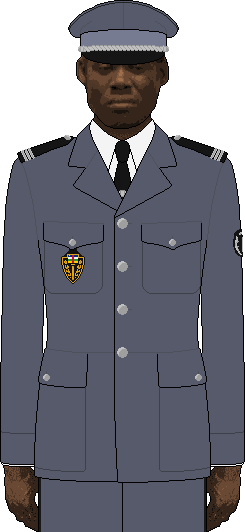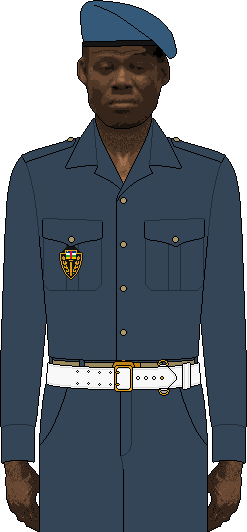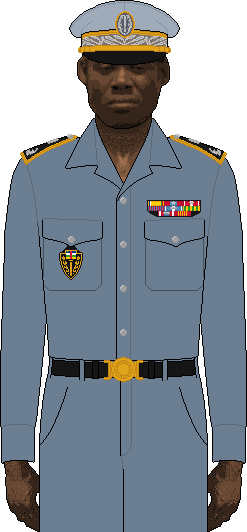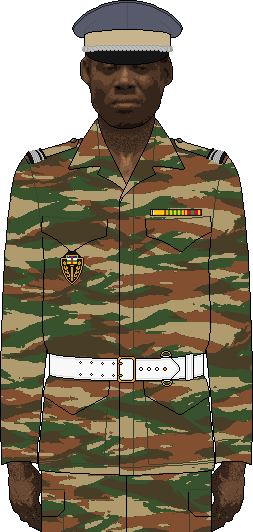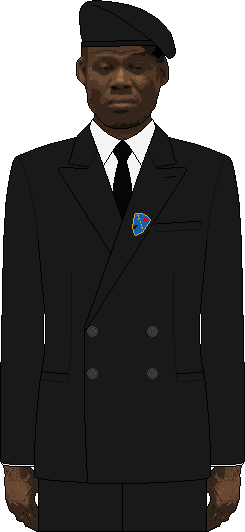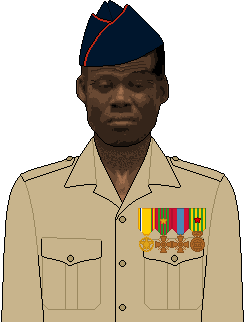UNIFORMS AND INSIGNIA OF THE CENTRAL AFRICAN EMPIRE
2. The Police, the MESAN, UNIDENTIFIED UNIFORMS
THE POLICE.
The formal name is unclear to me – going off the painted helmets (described below) they may have started out as the “Police Nationale” and changed to the “Police Centrafricaine” by 1975.
In general, the details here are somewhat more obscure than for the army and gendarmerie. There are no insignia close-ups because, apart from the pucelle [Fig. 24] I haven’t seen views of any of it good enough to prepare separate illustrations.
Fig. 57. Policeman, police, 1977.
Fig. 58. Motorcycle policeman, police, 1977.
Parade uniform. [Fig. 57] The attribution of this one is a little unclear. It’s rather “gendarmerie” in its ambience, at least to my eyes – but all the gendarmerie orders of dress are, I think, accounted for, the badge on the kepi isn’t a grenade, whatever it is, and, decisively, the gendarmerie sleeve shield is absent. In some respects this is a poor fit with the other orders of dress, however – its overall ambience and also the use of gold distinctions, in contrast to the silver otherwise used. I don’t believe I’ve seen this uniform, or the white equivalent (below) earlier than the coronation – was it purchased, from French surplus, specifically for this occasion, to give the rather disparate-looking police a smarter and more standardised appearance?
Anyway. Dark blue four-pocket tunic with white shirt and black tie as illustrated. Gold(?) buttons and silver(?) tie clip. Dark blue trousers with white stripe. Plain white shoulder boards for all ranks – where insignia was worn, I don’t know. Pucelle of what seems to be the “police” type I’ve also given to the Imperial Guard (see Fig. 24, previous page). Dark blue kepi with gold top band and chinstrap. Dark blue crown. Breast badge of unclear design – a shield shape, but the details escape me [Fig. 59]. White belt with solid gold buckle of unclear design. Straight dark blue trousers with white stripe, black shoes. White gloves.
Fig. 59. The best view I can find of the police badge. © the Institut National de l'Audiovisuel.
Motorcycle parade uniform. [Fig. 58] As above except as noted. Black detachable shoulder straps with rank insignia. A white cross-strap on the belt, white gauntlets. White crash helmet with unclear front central badge and stripe around the outside of the helmet, both in orange. Goggles worn atop this. Footwear unclear. At coronation-related festivities some of the motorcycles had two small flags at the front – the national flag on the right and the imperial standard on the left.
Fig. 60. Policeman, motor police(?), 1977.
Fig. 61. Motorcycle policeman, motor police(?), 1977.
White parade uniform. [Fig. 60] This seems to be the distinctive uniform of some special branch of the police, and not e.g. a summer alternative to the parade uniform described above – one sees them alongside each other in the footage. My best guess is that these men were traffic police, motor police, or some such, by reference to other countries where white seems to have been the distinctive colour of these branches. The uniform itself the same as the blue parade uniform described above, except as noted. Black detachable shoulder straps. Pucelle worn, but not consistently – design unclear but I must assume the standard police pattern. Kepi crown seems to have been the same dark blue as the body. White belt with gold open buckle. Short white spat-type gaiters can be seen on one occasion. For prise d’armes white gloves with gauntlets were worn. I don’t see any incidences of the circular police badge.
White motorcycle parade uniform. [Fig. 61] As the white parade uniform except as noted. Black belt (buckle unclear) with narrow black cross-strap. White crash helmet with unclear front central badge and stripe around the outside of the helmet, both in orange. Goggles worn. Footwear unclear. The same motorcycle flags as described above.
Fig. 62. Capitaine, police, 1975.
Fig. 63. General, police, 1975.
Service dress (“tenue vareuse”). [Fig. 62] Four-pocket tunic of somewhat varied colour – either a greyish blue or a blueish grey. Silver buttons. Chest pockets gently pointed, with pleated(?) bodies. Skirt pockets with straight flaps and unpleated bodies. No collar insignia. The police pucelle. Black or dark blue (unclear) detachable shoulder straps with rank insignia but no device. Officers wore silver bars and the men chevrons – presumably, then, the French police system or something close to it. Some kind of sleeve insignia, distantly seen – a wreath with an arc above, both silver(?), on a black(?) circle(?). Perhaps some variant of the pucelle design, without the flag. Peaked cap with the crown in the same colour with black piping around the upper end. The band seems to have varied enormously in colour – sometimes a lighter shade of the crown, other times tan or grey. Black, white, or no piping. Worn with silver(?) twisted(?) chinstrap and, so far as I can see, no badge. Straight trousers in the same colour as the tunic with black stripe, black shoes.
Service dress (“tenue vareuse”) (generals). The best attested figure is illustrated as Fig. 63. Peaked cap, the crown the same colour as the tunic, the band grey with gold upper trim and silver foliate embroidery. Gold chinstrap. The badge unclear – the illustration is my best conjecture. The central element I take to be the same truncheon (or whatever it is) as on the pucelle. Double-breasted tunic in the same colour as for lower ranks, silver buttons. Skirt pocket flaps with no buttons. Three buttons at each cuff – they look quite decisively gold in their single photograph but, they must surely be silver. Grey detachable shoulder straps in French shape with broad gold trim with a fairly zig-zag inner edge (some sort of closely repeating foliate pattern, I assume). The devices seem to have been two separate items: a vertical element (a truncheon, like on the cap badge?) above a single leaf or branch, which was perhaps the actual rank insignia. Silver aiguillette. Straight trousers in the same colour as the tunic with black stripe (just a single stripe), black shoes. I’ve drawn all of this a little sketchily because it’s well illustrated in Photo 1. As incongruous as this double-breasted tunic is, I’ve seen it worn by more than one general, so it can’t have been anyone’s personal idiosyncrasy. A general can be seen in a single photo, with what appears to be the same cap and insignia, but a conventional four-pocket tunic (pocket bodies visible, breast pockets pleated, breast pocket flaps slightly pointed, skirt pocket flaps straight).
Fig. 64. Policeman, police, 1974.
Fig. 65. Policeman, police, 1975.
Fig. 66. Policeman, police, 1975.
Fig. 67. Policeman, police, 1977.
Field service/fatigue dress. [Figs. 64-67] The regulation uniform seems to have been a greyish blue (the exact shade varying considerably) shirt and trousers. Shirt with pleated pockets, clipped corner pocket flaps. The standard trouser belt, in tan with gold solid buckle. White waistbelt with gold open buckle and cross-strap also sometimes seen, worn on top of the trouser belt. Black or dark blue (unclear) detachable shoulder straps sometimes worn. Pucelle sometimes worn. Headgear a peaked cap, entirely without insignia. The colour is hard to pin down but it seems to have been more tan than the clothing. Silver or matching colour fabric chinstrap (unclear), which seems not always to have been pleasant. One man can be seen with a light blue beret, at the wrong angle for seeing any badge. Insignia-less tan fatigues can also be seen, in material of earlier date. No doubt they continued in use here and there.
Fig. 68. General, police, 1975.
Field service/fatigue dress (generals). [Fig. 68] As above except where noted. Silver buttons. Black leather belt (buckle unclear). Black detachable shoulder straps with gold trim – there’s an illegible central device which I assume is the same as for the generals’ service dress. Cap as for generals’ service dress in a light blueish grey.
Fig. 69. Commandant, police, 1975.
Camouflage. [Fig. 69] Two men can be (distantly, blurrily) seen wearing what looks like Type B camouflage. One man wears a peaked cap and the other a light blue beret, again at the wrong angle for seeing any badge.
Helmets. A various picture, as with the army. Gueneau helmets, French surplus police helmets (see Fig. 21A) and French model 1951s, all in green. The first two items can be seen with blue bands painted around the crowns, with white central letters – earlier, “P N”, later “P C”. I put the change around the start of 1975.
The police badge. [Fig. 59] I’ve mentioned this above already. As well as uniformed policemen, this badge can also be seen on some men in suits: presumably plain-clothes officers, detectives or the like.
Armament. Men can be seen with long rifles and MAT-49s. Men in the white uniform are seen with short rifles.
THE MESAN.
The MESAN (Mouvement pour l'évolution sociale de l'Afrique noire) was the single political party allowed under the Empire – it pre-dated Bokassa, but was co-opted by him. Bokassa, when in civilian clothes, can often be seen wearing the blue MESAN badge [Fig. 70] on his lapel – I think I also see it on a single infantry officer, in camouflage.
The rank and file were not uniformed, although men and women can sometimes be seen in colourful outfits with patriotic motifs. A post-coronation ceremony shows a group of civilians marching in formation – they all wear black or dark blue suits, and may be some sort of party organisation. The MESAN badge is of course commonly seen.
Fig. 70. The MESAN badge, courtesy of Wikipedia.
Fig. 71. MESAN musician, 1976.
The band. [Fig. 71] A decent-sized band can be seen in 1975 footage. Black suits in the prevailing civilian style (long jackets, many probably double-breasted), flared trousers for men and skirts for women. Black shoes. Black berets pulled to the left, without badge. White shirt and black ties. On another occasion they appear sans jacket and tie. On yet another occasion they can be distantly seen, in black, with red stripes on their trousers — whether this was accompanied by a different jacket and/or beret I can’t tell. The MESAN badge worn on the left lapel. The conductor wore white gloves with gauntlets. The drums had banners arranged like the national flag, with “MESAN” across the green stripe (the “S” in the centre of the red stripe). Buglers had pentagonal (a straight line to the bottom of the green stripe, then coming sharply inwards at about 45 degrees) banners with the same arrangement. The bugle banners had yellow fringes and presumably the drum banners did also.
THE VETERANS.
Fig. 71A. Veteran, 1975.
These men had a paramilitary appearance — tan military shirts and full medals. The colour party wore white belts, white gloves with gauntlets, and dark ties. I’m less certain about the headgear — in the only colour footage I’ve seen the whole group is wearing dark blue calots piped red, some with a gold badge. This could either be a specific headgear for the veterans, or simply the French army colonial infantry calots they would have worn during WWII (the badge in that case being the standard fouled anchor). In footage of the celebrations of Centrafrican independence in 1960, one can also see some kepis etc. The waist and below I have no information, so this illustration is a little truncated. I’ve given this guy a Centrafrican medal and three French campaign medals.
UNKNOWN uniform 1.
I have seen exactly two men wearing this uniform, but, very surprisingly, I’ve been able to find two items of its insignia for sale at various points, so I can comment with at least a small degree of confidence.
Fig. 72. Unknown organisation 1 insignia (here, on the collar patch).
Fig. 73. Unknown organisation 1 uniform, 1975. © William Karel / Getty Images.
Fig. 74. Unknown organisation 1 cap badge. Photo dated 1967, which may be incorrect. © Keystone France / Getty Images.
To talk about the insignia first – the device of this branch, or organisation, or whatever it was, is a bee, above a crossed hoe and musket. Some sort of “economic” reading I think is intended – the hoe, of course, standing for agriculture, and the bee for general industriousness, etc. No doubt Bokassa, if he had any personal input, would have also appreciated its French-imperial associations. Bokassa took a colourfully militaristic approach to his program of public works and internal improvements – he called it “Operation Bokassa”. Cross-reference that with the musket on the insignia, perhaps – is this the uniform of some sort of labour service? I don’t know, but that’s my best guess.
The uniform was a standard four-pocket service dress tunic, of unclear colour – straight pocket flaps, four buttons of unclear colour. Pucelle of illegible design. Pentagonal collar patches, I think in mid-blue, with the insignia in gold. Cap in the same colour as the tunic, the band slightly lighter. The crown seems to have been piped (blue?) The insignia on a mid-blue pentagonal backing on the crown (present on one figure, missing on the other), and a second device on the band – a metal (i.e. not embroidered) wreath around a central item I can’t make out. Chinstrap comprising two twisted cords. Black(?) detachable shoulder boards with, I think, the same insignia embroidered in gold. Trousers the same colour as the tunic, black shoes.
UNKNOWN uniform 2.
Strange as it may seem, this might in fact be an army uniform. The cap badge seen on the junior officers is the standard army badge, of course, but I was reluctant to assign these uniforms there because, in every other regard, they’re inconsistent with the schemes used by the army. However, Bokassa’s son-in-law Felix Obrou, who the sources invariably describe as an army captain, seems to have been wearing this uniform (indeed, with a captain’s rank stripes) at his wedding.
Fig. 75. Commandant, unknown organisation 2, 1975.
Fig. 76. Junior general(?), unknown organisation 2, 1975.
Fig. 77. Senior general(?), unknown organisation 2, 1975.
Service dress (“tenue vareuse”), officers. [Fig. 75] Dark blue single-breasted tunic with, so far as I can see, no exterior pockets. Open collar with no insignia, white shirt, black tie. Four gold buttons. Gold rank bands on the lower cuff. Narrow passants of unclear colour and gold embroidery. Dark blue cap with either dark blue or grey-brown (same colour as the army) band. Army cap badge (see Fig. 6). Gold twisted chinstrap. Dark blue trousers and black shoes.
Service dress (“tenue vareuse”), generals (lower grade)(?). [Fig. 76] As above except where noted. Dark blue double-breasted tunic. Four non-contrasting buttons. Cuffs trimmed silver, with embroidered silver oak leaves above. Shoulder strap in army grey-brown with silver edging and silver devices, illegible. Silver trim and silver oak leaves on army grey-brown cap band. Cap badge unclear. Narrow silver chinstrap.
Service dress (“tenue vareuse”), generals (higher grade)(?). [Fig. 77] As lower grade generals except where noted. Front of the tunic unseen to me – I assume double-breasted. Gold cuff trim with two lines of embroidered gold oak leaves above. Gold distinctions on shoulder strap and cap. Two lines of embroidered gold oak leaves on cap band.
UNKNOWN uniform 3.
Fig. 78. Unknown uniform 3, 1975. © William Karel / Getty Images.
Seen once, on the figure shown above. Evidently an army uniform, but the collar insignia and sleeve shield are unidentified.
UNKNOWN uniform 4.
Fig. 79. Unknown uniform 4, 1975. © the Institut National de l'Audiovisuel.
Seen once, on the figure shown above. The hat is hard to make out in the above screenshots but it’s in “pillbox” style. Possibly police, in view of the shoulder straps.
UNKNOWN uniform 5.
Fig. 80. Unidentified insignia. © Shutterstock.
A man can be seen in the background of a single photo wearing what seems to be a standard army officer’s uniform, but with an unidentified pucelle of the type pictured.
Last updated: 26 September 2022
17 September 2022






